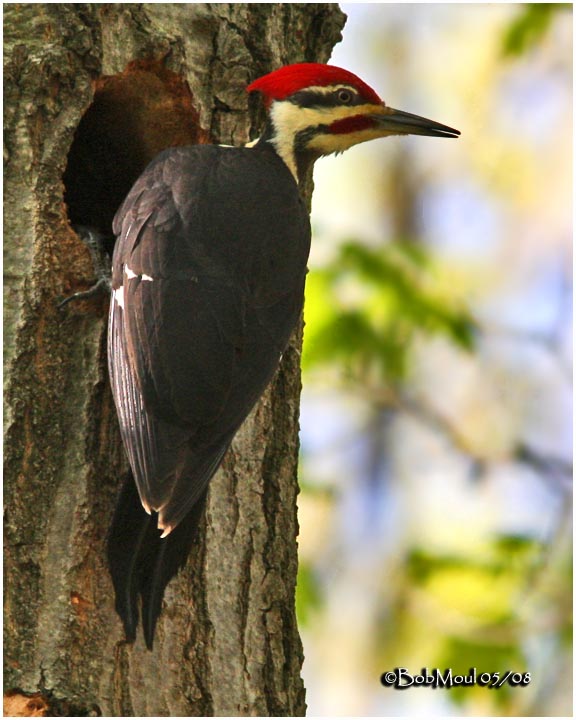
Pileated Woodpecker
Dryocopus pileatus
Piciforme Order – Picidae Family
BIOMETRICS:
Length: 40-49 cm; Wingspan: 66-75 cm; Weight: 250-350 g
LONGEVITY: up to 9 years
DESCRIPTION:
Pileated Woodpecker male is one of the largest woodpeckers of North America. It is almost entirely black on back and wings. It has white chin and dark silvery grey bill, and red crest and forehead. It shows black and white stripes on face, the first extending from base of bill down neck to upper flanks, and the other above the eyes. It has red moustache stripe. In flight, we can see its white underwings.
It has long, sharp and pointed bill, and a long tongue with barbs and sticky saliva. Eyes are yellow. Legs and feet are dusky, almost blackish.
Female has black forehead, and only black and white face. She lacks red moustache.
Immature is similar to adults, but its crest is shorter, and it has brown eyes.

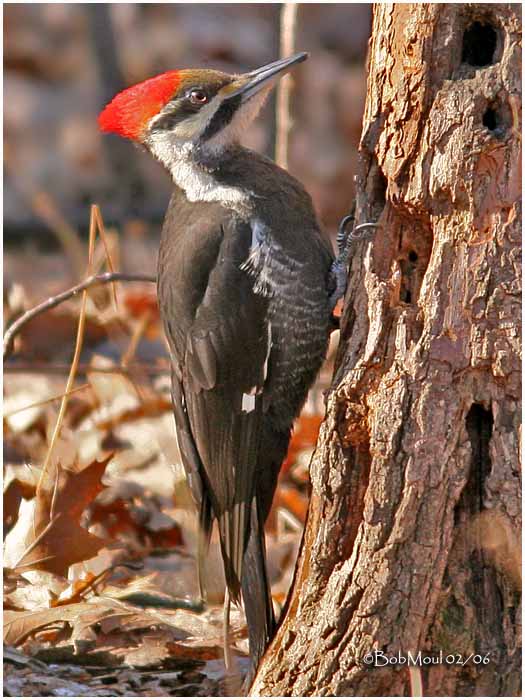
VOICE: SOUNDS BY XENO-CANTO
Pileated Woodpecker’s call is a loud “wuck” note, or series of notes, given all year round and often in flight. To proclaim a territory, it uses drumming.
HABITAT:
Pileated Woodpecker lives in coniferous or deciduous forests. It prefers open forests with large trees.
RANGE:
Pileated Woodpecker is resident in its range all year round, from British Columbia, eastward across southern Canada to Nova Scotia, southward to northern California, Central Texas and Florida.
BEHAVIOUR:
Pileated Woodpecker excavates typical oval or rectangular holes in tree-trunks, to find ants. These feeding excavations are very extensive and they attract other birds. To feed, Pileated Woodpecker gleans from branches and logs, prying off long slivers of wood to find ants.
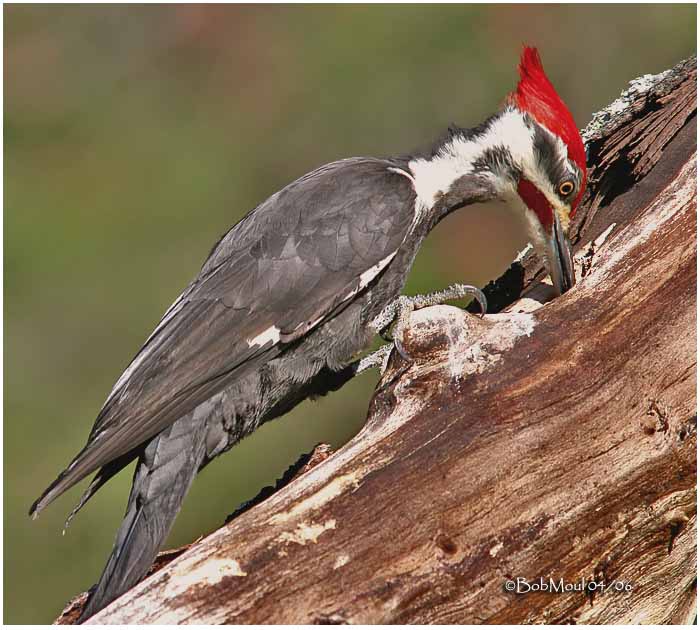
Pileated Woodpecker doesn’t migrate, only moving southward for northern birds in fall.
Pileated Woodpeckers often live in groups, sharing up to 30 tree cavities. This bird is adapted to climb on vertical surfaces, but sometimes, it hops on the ground. It roosts in cavity during the night.
When there is conflict with other species, Pileated Woodpecker chases them, calling, striking its wings and jabbing with its long bill.
Drumming serves to proclaim territory. It is a rapid pecking on a resonant tree or limb. It is most frequent in the morning, but also through the day, increasing in frequency when courtship displays begin. These drumming can be heard for long distances.
Pileated Woodpecker is monogamous, and pairs stay together year round, on their territories.
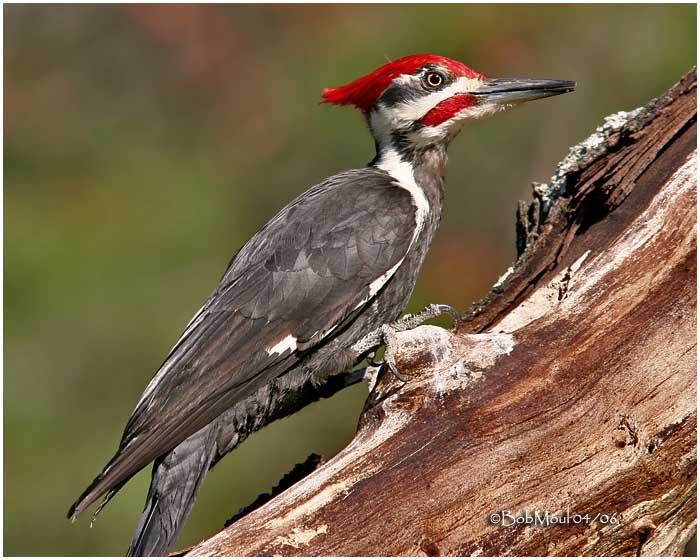
FLIGHT:
Pileated Woodpecker is a strong flyer, with slightly undulating flight. This flight is rather slow, but vigorous and direct. In flight, we can see its conspicuous underwing white patches.
REPRODUCTION:
Pileated Woodpecker nest in cavities, excavated in old pines. The bird pecks the bark around the entrance, to get the sap flowing around the hole. This sticky sap keeps predators away from the nest. It may make up to 15 holes in the same tree, allowing escape routes for its safety. Male and female excavate the cavity, at about 15 to 80 feet above the ground. The hole is lined with wood chips.
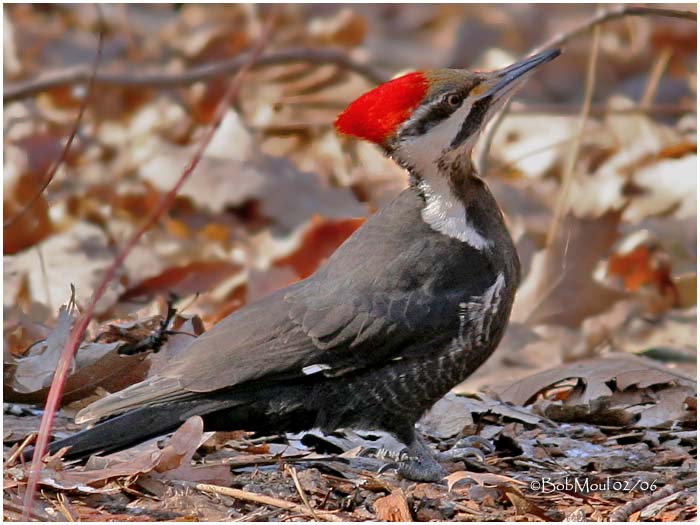
Female lays 3 to 5 glossy white eggs. Incubation lasts about 15 to 18 days, by both parents, male during the night and alternately during the day. Young hatch altricial. They are fed by regurgitated food and both parents brood them for the first 7 to 10 days. They fledge at about 26 to 28 days after hatching, but they remain with their parents for 2 to 3 months more, to learn to forage.
DIET:
Pileated Woodpecker feeds mainly on insects from under the bark, such as Carpenter Ants. They also eat acorns, fruits, seeds and sometimes tree sap.
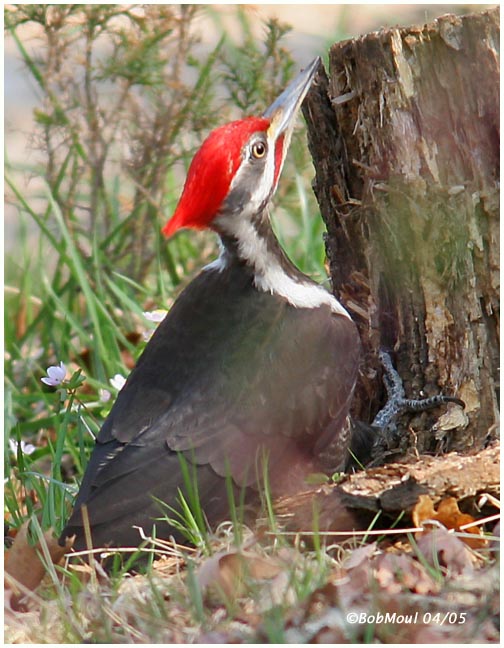
PROTECTION / THREATS / STATUS:
The most important threat is habitat destruction, with clear-cutting of old forests and others, reducing possibilities to cavity-nest.
Shooting for sport is now illegal, but this practice continues in some places.
But Pileated Woodpeckers are fairly adaptable, and these threats don’t affect significantly the populations.
Predators are squirrels, tree-climbing snakes and birds of prey.
Fr: Grand pic
All : Helmspecht
Esp : Picamaderos Norteamericano
Ital : Picchio Pileato
Nd : Noordamerikaanse Zwarte Specht
Sd : Amerikansk Spillkraka
Photos de Bob Moul
Son site :
Nature Photography
Texte de Nicole Bouglouan
Sources:
HANDBOOK OF THE BIRDS OF THE WORLD Vol. 7 by Josep del Hoyo-Andrew Elliott-Jordi Sargatal – Lynx Edicions – ISBN: 8487334377
FIELD GUIDE TO THE BIRDS OF NORTH AMERICA - National Geographic Society - ISBN: 0792274512
All About Birds (Cornell Lab of Ornithology)
Animal Diversity Web (University of Michigan Museum of Zoology)
What Bird-The ultimate Bird Guide (Mitchell Waite)
Wikipedia (Wikipedia, The Free Encyclopedia)
Bird Web (Seattle Audubon Society)